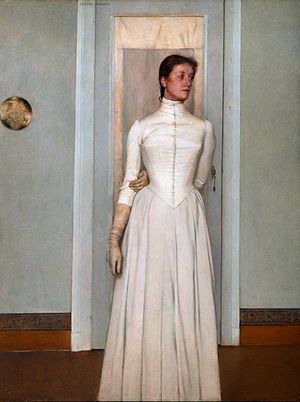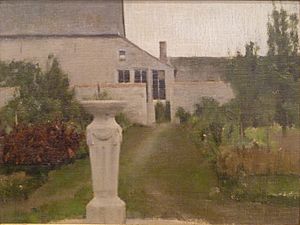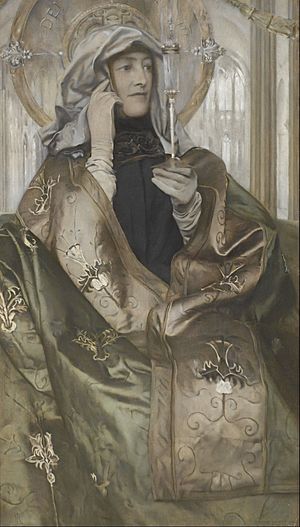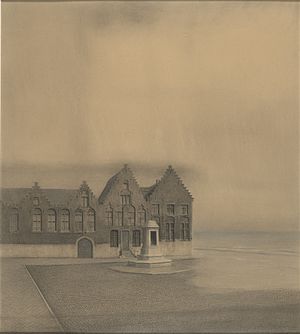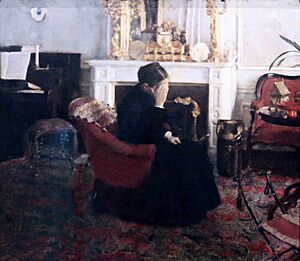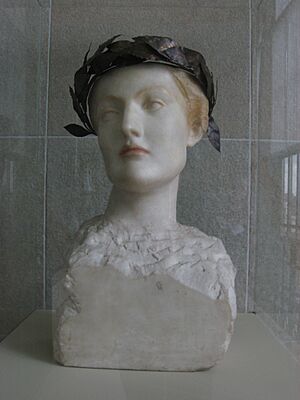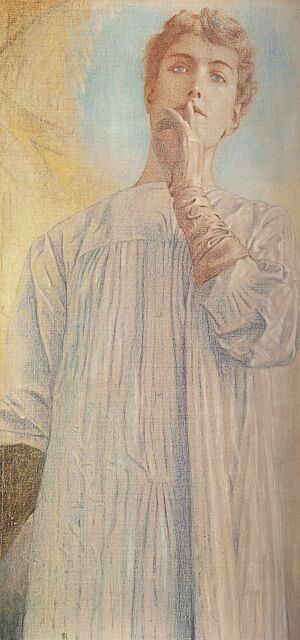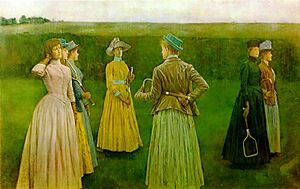Fernand Khnopff facts for kids
Quick facts for kids
Fernand Khnopff
|
|
|---|---|
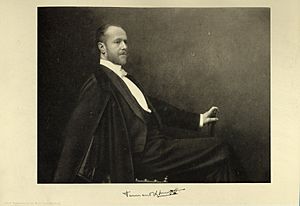
Fernand Khnopff (c. 1900)
|
|
| Born |
Fernand Edmond Jean Marie Khnopff
12 September 1858 Grembergen, East Flanders, Belgium
|
| Died | 12 November 1921 (aged 63) Brussels, Province of Brabant, Belgium
|
| Education | Xavier Mellery Académie Royal des Beaux-Arts, Brussels Académie Julian, Paris |
| Known for | Painter, sculptor, designer |
|
Notable work
|
Caress of the Sphinx |
| Movement | Symbolism |
| Awards | Commander in the Order of Leopold Officer of the Légion d'Honneur |
Fernand Edmond Jean Marie Khnopff was a famous Belgian painter. He was born on September 12, 1858, and passed away on November 12, 1921. He is known for his unique style called Symbolism.
Contents
About Fernand Khnopff's Life
Early Life and Education
Fernand Khnopff came from a rich family. Many of his male relatives were lawyers or judges. Fernand was expected to follow in their footsteps.
When he was a young child, from 1859 to 1864, he lived in Bruges. His father worked there as a lawyer. Fernand's memories of this old city later inspired his art. In 1864, his family moved to Brussels. He also spent summers at his grandparents' estate near Bastogne. He painted many scenes from this village.
When he was 18, Fernand started law school. This was at the Free University of Brussels. But he was not very interested in law. Instead, he loved reading books. He discovered writers like Baudelaire and Flaubert.
Fernand left law school because he found it boring. He then started studying art with Xavier Mellery. Mellery taught him about painting. On October 25, 1876, Fernand joined the Académie Royale des Beaux-Arts. There, he met James Ensor, another famous artist. But they did not get along well.
Between 1877 and 1880, Khnopff traveled to Paris many times. He saw the works of famous painters like Eugène Delacroix and Gustave Moreau. At the Paris World Fair in 1878, he also saw art by John Everett Millais and Burne-Jones. During his last year at the Académie, he spent time in Paris. He took art classes at the Académie Julian.
Starting His Art Career
In 1881, Fernand Khnopff showed his art to the public for the first time. This was at an exhibition in Brussels. Most critics did not like his work. But Emile Verhaeren, a writer, praised him. Verhaeren became a lifelong supporter of Khnopff. He even wrote the first book about the painter.
In 1883, Khnopff helped start an art group called Le Groupe des XX. He showed his art regularly at their yearly exhibitions.
In 1885, he met Joséphin Péladan, a French writer. Péladan asked Khnopff to design a book cover. It was for his novel Le Vice suprême. Khnopff made the design. But he later destroyed it. A famous singer, Rose Caron, thought the portrait on the cover looked like her. She was very upset. This caused a big scandal in the newspapers. But it also made Khnopff more famous as an artist.
Khnopff continued to create art for Péladan's books. He also showed his work at Péladan's "Salon de la Rose + Croix" exhibitions in Paris.
Later Years and Achievements
In 1889, Khnopff began to connect with artists in England. He visited and showed his art there often. He became friends with British artists like William Holman Hunt and Burne-Jones. From 1895, Khnopff wrote for a British art magazine called The Studio. He reported on art news from Belgium and Europe.
In March 1898, Khnopff showed 21 of his works in Vienna. His art was greatly admired there. It even influenced the famous artist Gustav Klimt.
Around 1900, Khnopff designed his own house and art studio in Brussels. The house was inspired by a style called the Vienna Secession. He made his home a "Temple of the self." His motto, "On a que soi" (One has but oneself), was above the entrance. In his studio, he painted a golden circle on the floor. This special setting showed his love for theater and opera.
Khnopff started designing for the theater in 1903. He created sets for a play in Berlin. These sets showed the dark streets of Bruges. The audience loved them. He also designed costumes and sets for operas in Brussels. He worked on more than a dozen opera productions.
In 1904, he was asked to decorate the "Wedding Room" in the Saint Gilles Town Hall. He also designed panels for a rich banker's music room. There, he met other artists from the Vienna Secession. This included Josef Hoffmann, the architect, and Gustav Klimt.
Even though Khnopff was a private person, he became very famous during his lifetime. He received the Order of Leopold, a special award. His sister, Marguerite, was often a model for his paintings. His most famous painting is probably Caress of the Sphinx. His art often showed women in two ways: as dangerous or as angelic.
Fernand Khnopff is buried in Laeken Cemetery.
Awards and Recognition
- 1919: He was made a Commander of the Order of Leopold.
- He was a member of the Royal Academy of Science, Letters and Fine Arts of Belgium.
- A street in Grembergen, Belgium, is named after him: "Fernand Khnopffstraat."
Famous Works in Public Collections
Here are some of Fernand Khnopff's artworks that you can see in museums:
- Amsterdam, Van Gogh Museum
- Portrait of the violinist Achille Lerminiaux, 1885.
- Antwerp, Koninklijk Museum voor Schone Kunsten Antwerpen:
- Portrait of Edmond Khnopff, father of the painter, 1881.
- Bruges, Groeningemuseum
- "Secret-Reflect" (Secret-Reflection), 1902.
- Brussels, Royal Museums of Fine Arts of Belgium:
- "En écoutant Schumann" (Listening to Schumann), 1883.
- "Portrait of Marguerite Khnopff", sister of the painter, 1887.
- "Du silence" (Silence), 1890.
- "A Fosset, sous les sapins" (In Fosset, under the firs), 1894.
- "Caress of the Sphinx", 1896.
- "Memories" or "Lawn Tennis", 1889.
- "Posthumous portrait of Marguerite Landuyt", 1896.
- "Portrait of His Royal Highness" Prince Leopold of Belgium, 1912.
- "Portrait of Miss Van der Hecht", 1883.
- "Portrait of Germaine Wiener, 1893.
- "Blanc, noir et or" (White, black and gold), 1901.
- "Un masque de jeune femme anglaise" (A mask of a young English woman), 1891.
- "Sculpture (bust) in polychromed plaster".
- "Sous les arbres" (Under the trees), 1894.
- "Une ville abandonnée" (An abandoned city), 1904.
- Brussels, Collection of the BOZAR:
- "Portrait of a man", around 1885.
- Budapest, Museum of Fine Arts:
- "À Fosset, Un ruisseau" (In Fosset, A brook), 1897.
- Dendermonde, Stedelijke Musea:
- "Paysage à Fosset", around 1894.
- Elsene/Ixelles, Musée d'Ixelles/Museum van Elsene:
- "Portrait of Charles Maus", 1885.
- "Chimère" (Chimaera), around 1910.
- Frankfurt-am-Main, Städelsches Kunstinstitut und Städtische Galerie:
- "À Fosset, Le garde qui attend" (In Fosset, The forester who waits), 1883.
- Ghent, Museum of Fine Arts, Ghent:
- "L'Encens" (Incense), around 1898.
- "A Fosset, Un sentier" (In Fosset, a track), around 1890–1895.
- "Des yeux bruns et une fleur bleue", 1905.
- Hamburg, Kunsthalle Hamburg:
- "Un Masque" (A mask), 1897. This is a sculpture.
- Liège, Musée d'art moderne et d'art contemporain:
- "Portrait of the mother of the artist, 1882.
- "Orphée" (Orpheus), 1913.
- "l'Isolement" ("The Isolation", part I and part III of a three-part painting).
- "Les cheveux" (Hair), 1892.
- Los Angeles, J. Paul Getty Museum:
- "Portrait of Jeanne Kéfer, 1885.
- Munich, Bayerische Staatsgemäldesammlungen, Neue Pinakothek:
- "I lock my door upon myself", 1891.
- Neuss, Clemens Sels Museum:
- "A Bruges, un portail" (In Bruges, a portal), around 1904.
- New York City, Metropolitan Museum of Art
- "l'Offrande" (The offering), 1891.
- Ostend, Museum voor Schone Kunsten:
- "View from the bridge at Fosset, around 1882–1883.
- Paris, Musée d'Orsay:
- "Portrait of Marie Monnom (Later wife of Théo van Rysselberghe), 1887.
- Verviers, Musées Communaux:
- "A Bruges, une église" (In Bruges, a church), 1904.
- Vienna, Österreichische Galerie Belvedere:
- "l'Eau immobile" (The immobile water), around 1894.
- Vienna, Graphische Sammlung Albertina:
- "Tête de jeune femme anglaise" (Head of a young English woman), 1895. This is a drawing.
See also
 In Spanish: Fernand Khnopff para niños
In Spanish: Fernand Khnopff para niños


